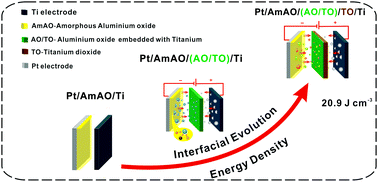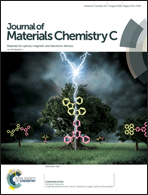Ultrahigh energy density due to self-growing double dielectric layers at a titanium/sol–gel-derived amorphous aluminium oxide interface†
Abstract
Pursuing high-energy-density dielectric materials is desirable for the growing demands of energy storage for dielectric capacitors in modern electric power systems. Herein, a simple titanium/sol–gel-derived amorphous aluminium oxide (Ti/AmAO) film is firstly presented. The structural evolution was that double dielectric layers of a compact TiO2 layer and an Al2O3/TiOx layer self-grow simultaneously at a Ti/AmAO interface under a high electric field. The high resistivities of the TiO2 layer (an order of magnitude of 109 Ω cm) and the Al2O3/TiOx layer (an order of magnitude of 1011 Ω cm) and the improved AmAO film contribute to improving the breakdown strength, and the high dielectric constant of the TiO2 layer (up to 28.1) serves to yield a high dielectric constant. Therefore, the interfacial evolution endows the film with a high breakdown strength of up to 548 MV m−1 and a high dielectric constant of 15.9. An energy density as high as 20.9 J cm−3 at 545 MV m−1 is achieved. Meanwhile, a growth model for the compact layers is proposed to comprehensively understand the interfacial behaviour. This work extends a novel approach of introducing interfacial evolution to improve the energy storage capacity of a dielectric capacitor.



 Please wait while we load your content...
Please wait while we load your content...